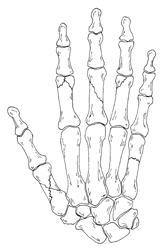Home | Education | Fractures and Sprain | Hand Fractures


Closed Reduction and Internal Fixation - A splint or cast may be used to treat a fracture that is not displaced, or to protect a fracture that has been set. Some displaced fractures may be held in place with wires or pins without making an incision.
Surgery - Once the bone fragments are set, they are held together with pins, plates, or screws (Figure 2). Occasionally bone may be missing or be so crushed that it cannot be repaired. In such cases, a bone graft may be necessary. In this procedure, bone is taken from another part of the body to help provide more stability.
External Fixation - The fracture will be set with metal bars outside the body attached to pins which are fixed to the bone above and below the fracture site until the break heals.
Call Dr. Smith at 713-524-0580 or send him an email for more information or to schedule an appointment concerning Hand Fractures.
The information on this webpage is based on material from the American Society for Surgery of the Hand and is for educational purposes only.

Hand Fractures
By Houston Hand Surgery Specialist & Orthopaedic Surgeon, Dr. Dean Smith
The hand skeleton is made up of many bones that form its supporting framework. This frame acts as a point of attachment for the muscles that make the wrist and fingers move. A fracture occurs when force is applied to a bone that is enough to break it. When this happens, there is pain, swelling, and decreased use of the injured part. Many people think that a fracture is different from a break, but they are the same (Figure 1).Figure 1: Examples of fractures in fingers.
Types of Fractures:
- Simple Fractures – Broken bone pieces are aligned and stable
- Comminuted (Shattered Bone) Fractures - Broken bone fragments are unstable, shifted or displaced typically as a result of a high energy impact
- Open (Compound) Fracture - a bone fragment breaks through the skin and there is some risk of infection
How do Hand Fractures Affect You?
A fracture can cause pain, stiffness, and loss of movement. Because of the close relationship of bones to ligaments and tendons, the hand may be stiff and weak after the fracture heals. Fractures that involve joint surfaces may lead to early arthritis in those involved joints.
How are Hand Fractures Treated?
Medical evaluation and X-rays are usually needed so that Dr. Smith can tell if there is a fracture and how to decide treatment. Depending upon the type of fracture to your hand, Dr. Smith might recommend one of several methods of treatment.Closed Reduction and Internal Fixation - A splint or cast may be used to treat a fracture that is not displaced, or to protect a fracture that has been set. Some displaced fractures may be held in place with wires or pins without making an incision.
Surgery - Once the bone fragments are set, they are held together with pins, plates, or screws (Figure 2). Occasionally bone may be missing or be so crushed that it cannot be repaired. In such cases, a bone graft may be necessary. In this procedure, bone is taken from another part of the body to help provide more stability.
External Fixation - The fracture will be set with metal bars outside the body attached to pins which are fixed to the bone above and below the fracture site until the break heals.
Figure 2: Examples of plates, pins, and screws used to join fractures while they heal.
Call Dr. Smith at 713-524-0580 or send him an email for more information or to schedule an appointment concerning Hand Fractures.